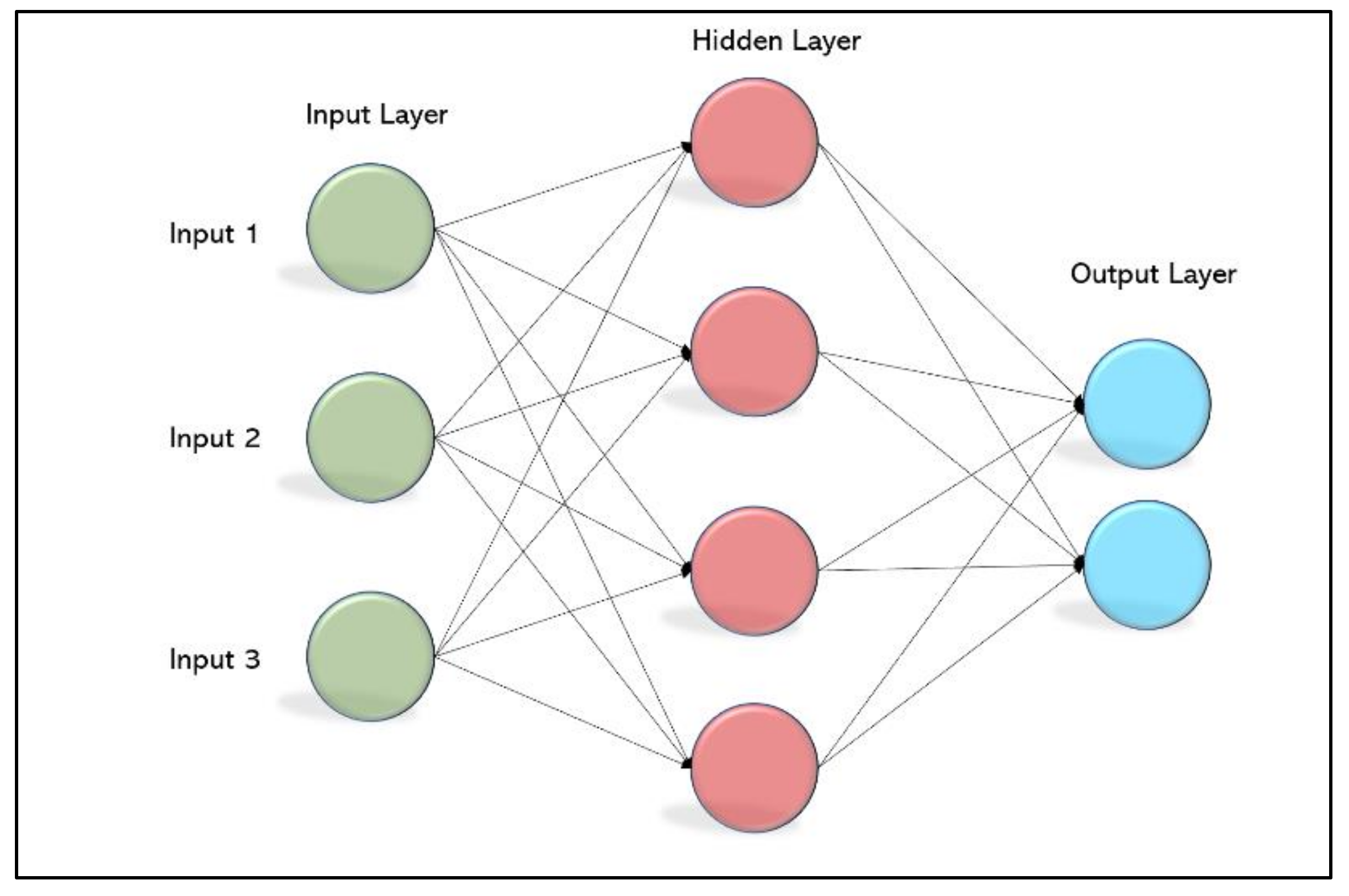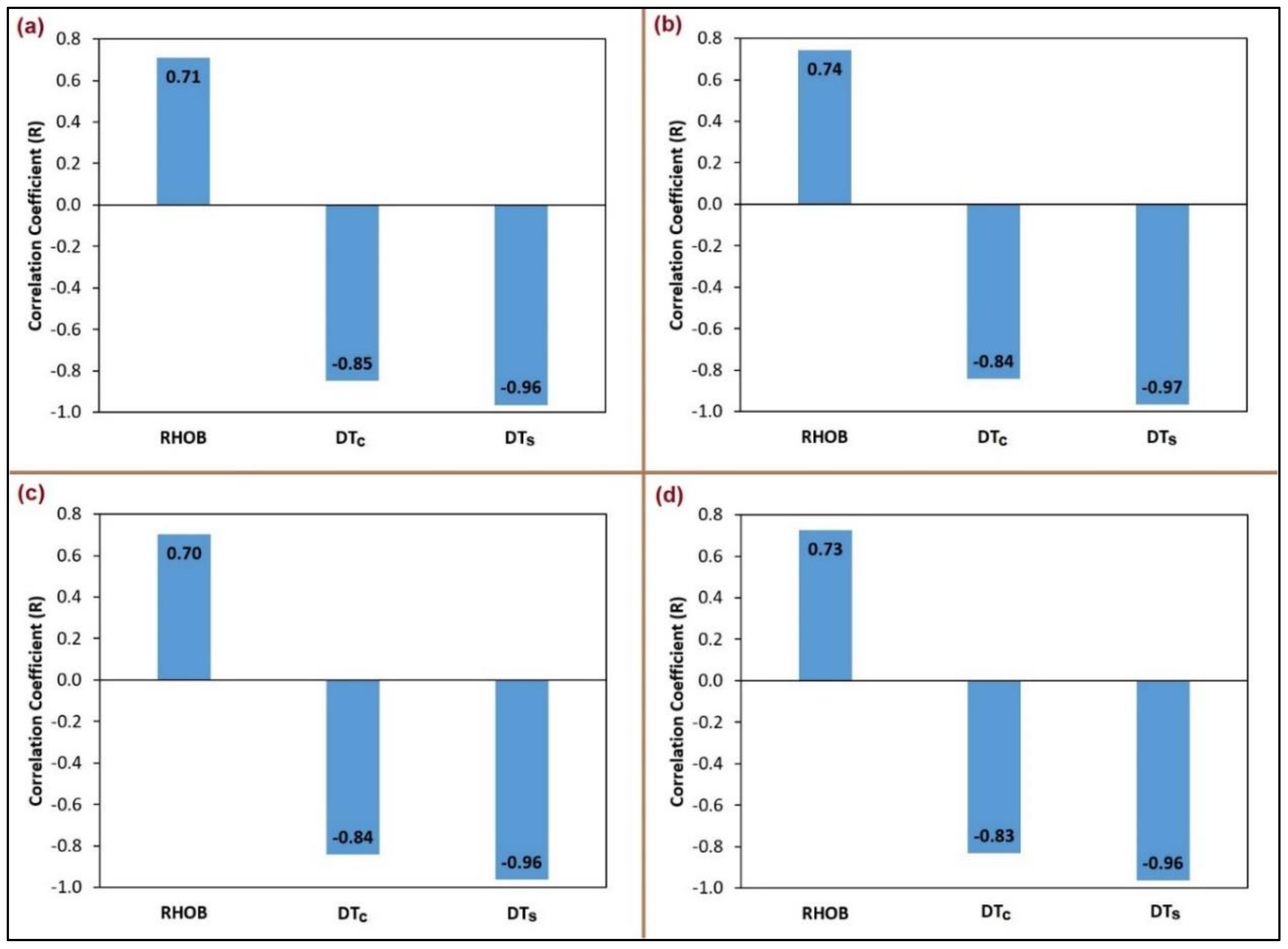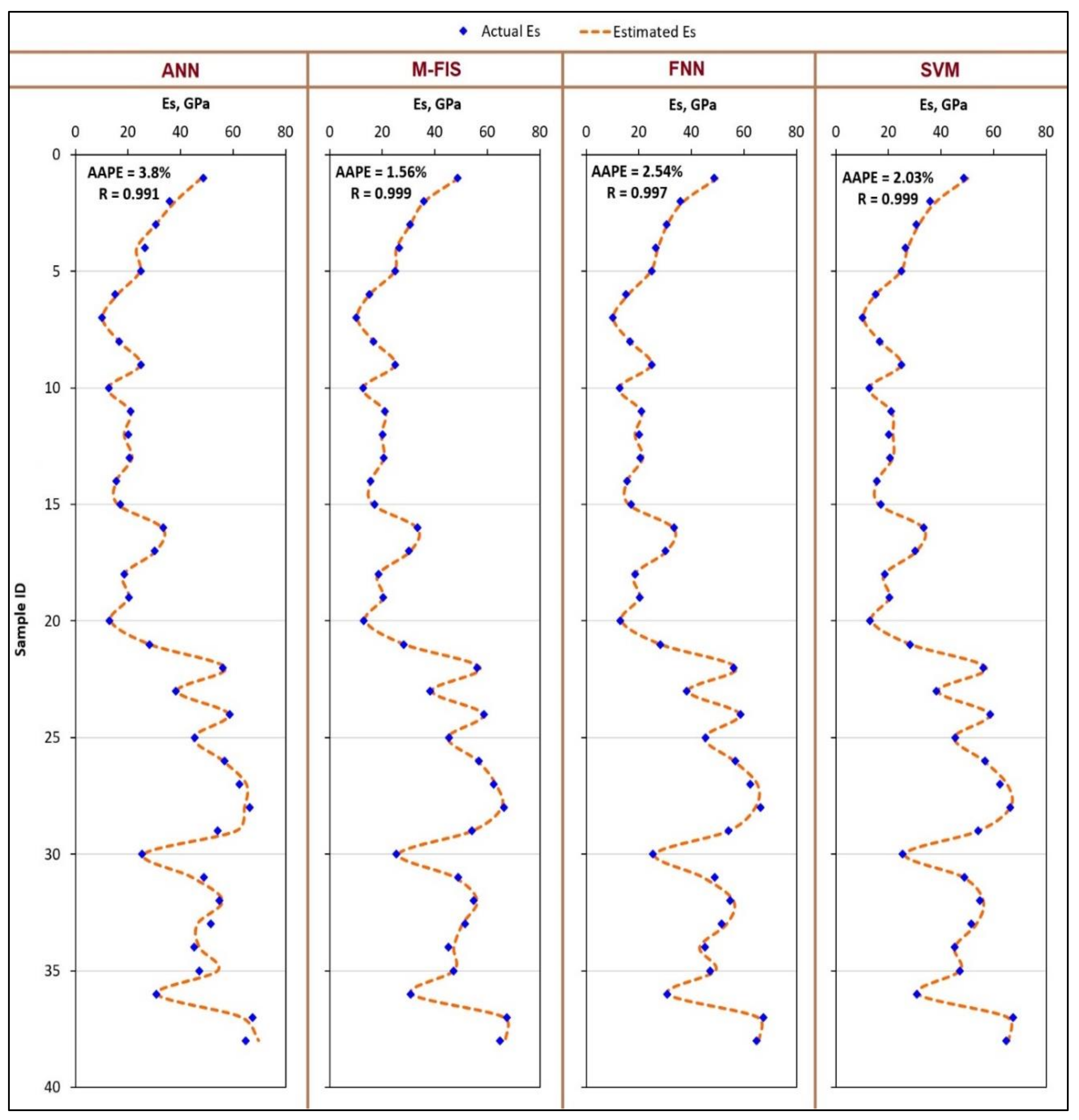Application of Machine Learning in Evaluation of the Static Young’s Modulus for Sandstone Formations
Abstract
:1. Introduction
2. Theory of Machine Learning Techniques Considered in This Study
3. Applications of Machine Learning in Petroleum Engineering
4. Application to the Well Log Data
4.1. Data Preparation
4.2. Training the Machine Learning Models
4.3. Evaluation of the Developed Machine Learning Models
5. Results and Discussion
5.1. Machine Learning Models Development
5.2. Testing the Developed Machine Learning Models
5.3. Validation of the Developed Machine Learning Models
6. Conclusions
Author Contributions
Conflicts of Interest
Nomenclature
| AAPE | Average absolute percentage error |
| ANN | Artificial neural networks |
| DTc | Compressional transit time |
| DTs | Shear transit time |
| Edynamic | Dynamic Young’s modulus |
| Estatic | Static Young’s modulus |
| FNN | Functional neural networks |
| M-FIS | Mamdani fuzzy interference system |
| SVM | Support vector machine |
| R | Correlation coefficient |
| RHOB | Formation bulk density |
References
- Britt, L.K.; Smith, M.B.; Haddad, Z.; Reese, J.; Kelly, P. Rotary Sidewall Cores—A Cost Effective Means of Determining Young’s Modulus. Proceeding of the SPE Annual Technical Conference and Exhibition, Houston, TX, USA, 26–29 September 2004. [Google Scholar] [CrossRef]
- Fjaer, E.; Horsrud, H.P.; Raaen, A.M.; Risnes, R. Petroleum Related Rock Mechanics, 2nd ed.; Elsevier Science: Amsterdam, The Netherlands, 2008; Volume 53, ISBN 9780080557090. [Google Scholar]
- Chang, C.; Zoback, M.D.; Khaksar, A. Empirical relations between rock strength and physical properties in sedimentary rocks. J. Pet. Sci. Eng. 2006, 51, 223–237. [Google Scholar] [CrossRef]
- Gatens, J.M.; Harrison, C.W.; Lancaster, D.E.; Guldry, F.K. In-situ stress tests and acoustic logs determine mechanical properties and stress profiles in the Devonian shales. SPE Form. Eval. 1990, 5, 248–254. [Google Scholar] [CrossRef]
- Meyer, B.R.; Jacot, R.H. Impact of Stress-Dependent Young’s Moduli on Hydraulic Fracture Modeling. In Proceedings of the 38th U.S. Symposium on Rock Mechanics, Washington, DC, USA, 7–10 July 2001. [Google Scholar]
- Nes, O.M.; Fjaer, E.; Tronvoll, J.; Kristiansen, T.G.; Horsrud, P. Drilling time reduction through an integrated rock mechanics analysis. J. Energy Resour. Technol. 2012, 134, 032802. [Google Scholar] [CrossRef]
- Howard, G.C.; Fast, C.R. Hydraulic Fracturing. In Doherty Memorial Fund of AIME, Society of Petroleum Engineers of AIME; Henry L.: New York, NY, USA, 1970; Volume 2, ISBN 10. [Google Scholar]
- Barree, R.D.; Gilbert, J.V.; Conway, M.W. Stress and Rock Property Profiling for Unconventional Reservoir Stimulation. In Proceedings of the SPE Hydraulic Fracturing Technology Conference, The Woodlands, TX, USA, 19–21 January 2009. [Google Scholar] [CrossRef]
- Rinehart, J.S.; Fortin, J.-P.; Burgin, L. Propagation Velocity of Longitudinal Waves in Rock. Effect of State of Stress, Stress Level of the Wave, Water Content, Porosity, Temperature Stratification and Texture. In Proceedings of the 4th Symposium on Rock Mechanics, University Park, PA, USA, 30 March–1 April 1961. [Google Scholar]
- Simmons, G.; Brace, W.F. Comparison of Static and Dynamic Measurements of Compressibility of Rocks. J. Geophys. Res. 1965, 70, 5649–5656. [Google Scholar] [CrossRef]
- King, M.S. Wave Velocities in Rocks as a Function of Changes in over burden Pressure and Pore Fluid Saturants. Geophysics 1966, 31, 50–73. [Google Scholar] [CrossRef]
- Larsen, I.; Fjær, E.; Renlie, L. Static and Dynamic Poisson’s Ratio of Weak Sandstones. In Proceedings of the 4th North American Rock Mechanics Symposium, Seattle, WA, USA, 31 July–3 August 2000. [Google Scholar]
- Hui, C.; Lian-Ku, X.; Li-Jie, G.; Hu-Xin, W.; Biao, C. Rock mechanics study on the safety and efficient extraction for deep moderately inclined medium-thick orebody. Electron. J. Geotech. Eng. 2015, 20, 11073–11082. [Google Scholar]
- Peng, L.; Xinrong, L.; Zuliang, Z. Mechanical Property Experiment and Damage Statistical Constitutive Model of Hongze Rock Salt in China. Electron. J. Geotech. Eng. 2015, 20, 81–94. [Google Scholar]
- King, M.S. Static and Dynamic elastic moduli of rocks under pressure. In Proceedings of the 11th U.S. Symposium on Rock Mechanics (USRMS), Berkeley, CA, USA, 16–19 June 1969. [Google Scholar]
- Canady, W.J. A Method for Full-Range Young’s Modulus Correction. In Proceedings of the North American Unconventional Gas Conference and Exhibition, The Woodlands, TX, USA, 14–16 June 2011. [Google Scholar] [CrossRef]
- Khaksar, A.; Taylor, P.G.; Fang, Z.; Kayes, T.J.; Salazar, A.; Rahman, K. Rock Strength from Core and Logs, Where We Stand and Ways to Go. In Proceedings of the EUROPEC/EAGE Conference and Exhibition, Amsterdam, The Netherlands, 8–11 June 2009. [Google Scholar] [CrossRef]
- Fei, W.; Huiyuan, B.; Jun, Y.; Yonghao, Z. Correlation of Dynamic and Static Elastic Parameters of Rock. Electronic J. Geotech. Eng. 2016, 21, 1551–1560. [Google Scholar]
- Mahmoud, M.A.; Elkatatny, S.A.; Ramadan, E.; Abdulraheem, A. Development of Lithology-Based Static Young’s Modulus Correlations from Log Data Based on Data Clustering Technique. J. Pet. Sci. Eng. 2016, 146, 10–20. [Google Scholar] [CrossRef]
- Abdulraheem, A.; Ahmed, M.; Vantala, A.; Parvez, T. Prediction of Rock Mechanical Parameters for Hydrocarbon Reservoirs Using Different Artificial Intelligence Techniques. In Proceedings of the SPE Saudi Arabia Section Technical Symposium, Al-Khobar, Saudi Arabia, 9–11 May 2009. [Google Scholar] [CrossRef]
- Tariq, Z.; Elkatatny, S.; Mahmoud, M.; Abdulraheem, A. A New Artificial Intelligence Based Empirical Correlation to Predict Sonic Travel Time. In Proceedings of the International Petroleum Technology Conference, Bangkok, Thailand, 14–16 November 2016. [Google Scholar] [CrossRef]
- Tariq, Z.; Elkatatny, S.M.; Mahmoud, M.A.; Abdulraheem, A.; Abdelwahab, A.Z.; Woldeamanuel, M. Estimation of Rock Mechanical Parameters Using Artificial Intelligence Tools. In Proceedings of the 51st U.S. Rock Mechanics/Geomechanics Symposium, San Francisco, CA, USA, 25–28 June 2017. [Google Scholar]
- Parapuram, G.K.; Mokhtari, M.; Hmida, J.B. Prediction and Analysis of Geomechanical Properties of the Upper Bakken Shale Utilizing Artificial Intelligence and Data Mining. In Proceedings of the SPE/AAPG/SEG Unconventional Resources Technology Conference, Austin, TX, USA, 24–26 July 2017. [Google Scholar] [CrossRef]
- Mahmoud, A.A.; Elkatatny, S.; Ali, A.; Moussa, T. Estimation of Static Young’s Modulus for Sandstone Formation Using Artificial Neural Networks. Energies 2019, 12, 2125. [Google Scholar] [CrossRef] [Green Version]
- Mahmoud, A.A.A.; Elkatatny, S.; Mahmoud, M.; Abouelresh, M.; Abdulraheem, A.; Ali, A. Determination of the total organic carbon (TOC) based on conventional well logs using artificial neural network. Int. J. Coal Geol. 2017, 179, 72–80. [Google Scholar] [CrossRef]
- Gurney, K. An Introduction to Neural Networks; UCL Press Limited: London, UK, 1997; ISBN 0-203-45151-1. [Google Scholar]
- Jang, R. ANFIS Adaptive Network Based Fuzzy Inference System. IEEE Trans. Syst. Man Cybern. 1993, 23, 665–685. [Google Scholar] [CrossRef]
- Jang, J.S.R.; Sun, C.T.; Mizutani, E. Neuro-Fuzzy and Soft Computing; Prentice Hall: Bergen, NJ, USA, 1997; ISBN 0132610663. [Google Scholar]
- Bello, O.; Asafa, T. A Functional Networks Softsensor for Flowing Bottomhole Pressures and Temperatures in Multiphase Production Wells. In Proceeding of the SPE Intelligent Energy Conference & Exhibition, Utrecht, The Netherlands, 1–3 April 2014. [Google Scholar] [CrossRef]
- Anifowose, F.; Abdulraheem, A. Fuzzy logic-driven and SVM-driven hybrid computational intelligence models applied to oil and gas reservoir characterization. J. Natl. Gas Sci. Eng. 2011, 3, 505–517. [Google Scholar] [CrossRef]
- Vapnik, V. Statistical Learning Theory; Wiley: New York, NY, USA, 1998; ISBN 978-0471030034. [Google Scholar]
- Rui, J.; Zhang, H.; Zhang, D.; Han, F.; Guo, Q. Total organic carbon content prediction based on support-vector-regression machine with particle swarm optimization. J. Pet. Sci. Eng. 2019, 180, 699–706. [Google Scholar] [CrossRef]
- Mohaghegh, S.; Arefi, R.; Ameri, S.; Hefner, M.H. A Methodological Approach for Reservoir Heterogeneity Characterization Using Artificial Neural Networks. In Proceedings of the SPE Annual Technical Conference and Exhibition, New Orleans, LA, USA, 25–28 September 1994. [Google Scholar] [CrossRef]
- Barman, I.; Ouenes, A.; Wang, M. Fractured Reservoir Characterization Using Streamline-Based Inverse Modeling and Artificial Intelligence Tools. In Proceedings of the SPE Annual Technical Conference and Exhibition, Dallas, TX, USA, 1–4 October 2000. [Google Scholar] [CrossRef]
- Mahmoud, A.A.; Elkatatny, S.; Abdulraheem, A.; Mahmoud, M.; Ibrahim, M.O.; Ali, A. New Technique to Determine the Total Organic Carbon Based on Well Logs Using Artificial Neural Network (White Box). In Proceedings of the SPE Kingdom Saudi Arabia Annual Technical Symposium and Exhibition, Dammam, Saudi Arabia, 24–27 April 2017. [Google Scholar] [CrossRef]
- Mahmoud, A.A.; Elkatatny, S.; Ali, A.; Abouelresh, M.; Abdulraheem, A. Evaluation of the Total Organic Carbon (TOC) Using Different Artificial Intelligence Techniques. Sustainability 2019, 11, 5643. [Google Scholar] [CrossRef] [Green Version]
- Mahmoud, A.A.; Elkatatny, S.; Ali, A.; Abouelresh, M.; Abdulraheem, A. New Robust Model to Evaluate the Total Organic Carbon Using Fuzzy Logic. In Proceedings of the SPE Kuwait Oil & Gas Show and Conference, Mishref, Kuwait, 13–16 October 2019. [Google Scholar] [CrossRef]
- Mahmoud, A.A.; Elkatatny, S.; Abouelresh, M.; Abdulraheem, A.; Ali, A. Estimation of the Total Organic Carbon Using Functional Neural Networks and Support Vector Machine. In Proceedings of the 12th International Petroleum Technology Conference and Exhibition, Dhahran, Saudi Arabia, 13–15 January 2020. [Google Scholar] [CrossRef]
- Elkatatny, S. Application of Artificial Intelligence Techniques to Estimate the Static Poisson’s Ratio Based on Wireline Log Data. J. Energy Resour. Technol. 2018, 140, 072905. [Google Scholar] [CrossRef]
- Mahmoud, A.A.; Elkatatny, S.; Ali, A.; Moussa, T. A Self-adaptive Artificial Neural Network Technique to Estimate Static Young’s Modulus Based on Well Logs. Proceedings of Oman Petroleum & Energy Show, Muscat, Oman, 9–11 March 2020. [Google Scholar] [CrossRef]
- Al-Shehri, D.A. Oil and Gas Wells: Enhanced Wellbore Casing Integrity Management through Corrosion Rate Prediction Using an Augmented Intelligent Approach. Sustainability 2019, 11, 818. [Google Scholar] [CrossRef] [Green Version]
- Salehi, S.; Hareland, G.; Dehkordi, K.K.; Ganji, M.; Abdollahi, M. Casing collapse risk assessment and depth prediction with a neural network system approach. J. Petrol. Sci. Eng. 2009, 69, 156–162. [Google Scholar] [CrossRef]
- Wang, Y.; Salehi, S. Application of real-time field data to optimize drilling hydraulics using neural network approach. J. Energy Resour. Technol. 2015, 137, 062903. [Google Scholar] [CrossRef]
- Ahmed, A.S.; Mahmoud, A.A.; Elkatatny, S. Fracture Pressure Prediction Using Radial Basis Function. In Proceedings of the AADE National Technical Conference and Exhibition, Denver, CO, USA, 9–10 April 2019. [Google Scholar]
- Ahmed, A.S.; Mahmoud, A.A.; Elkatatny, S.; Mahmoud, M.; Abdulraheem, A. Prediction of Pore and Fracture Pressures Using Support Vector Machine. In Proceedings of the 2019 International Petroleum Technology Conference, Beijing, China, 26–28 March 2019. [Google Scholar] [CrossRef]
- Mahmoud, A.A.; Elkatatny, S.; Abdulraheem, A.; Mahmoud, M. Application of Artificial Intelligence Techniques in Estimating Oil Recovery Factor for Water Drive Sandy Reservoirs. In Proceedings of the SPE Kuwait Oil & Gas Show and Conference, Kuwait City, Kuwait, 15–18 October 2017. [Google Scholar] [CrossRef]
- Mahmoud, A.A.; Elkatatny, S.; Chen, W.; Abdulraheem, A. Estimation of Oil Recovery Factor for Water Drive Sandy Reservoirs through Applications of Artificial Intelligence. Energies 2019, 12, 3671. [Google Scholar] [CrossRef] [Green Version]
- Abdelgawad, K.Z.; Elzenary, M.; Elkatatny, S.; Mahmoud, M.; Abdulraheem, M.; Patil, S. New approach to evaluate the equivalent circulating density (ECD) using artificial intelligence techniques. J. Petrol. Explor. Prod. Technol. 2019, 9, 1569. [Google Scholar] [CrossRef] [Green Version]
- Elkatatny, S.M. Real Time Prediction of Rheological Parameters of KCl Water-Based Drilling Fluid Using Artificial Neural Networks. Arab. J. Sci. Eng. 2017, 42, 1655–1665. [Google Scholar] [CrossRef]
- Al-AbdulJabbar, A.; Elkatatny, S.; Mahmoud, A.A.; Moussa, T.; Al-Shehri, D.; Abughaban, M.; Al-Yami, A. Prediction of the Rate of Penetration while Drilling Horizontal Carbonate Reservoirs Using the Self-Adaptive Artificial Neural Networks Technique. Sustainability 2020, 12, 1376. [Google Scholar] [CrossRef] [Green Version]
- Al-AbdulJabbar, A.; Elkatatny, S.M.; Mahmoud, M.; Abdelgawad, K.; Abdulaziz, A. A Robust Rate of Penetration Model for Carbonate Formation. J. Energy Resour. Technol. 2018, 141, 042903. [Google Scholar] [CrossRef]
- Elkatatny, S.; Al-AbdulJabbar, A.; Mahmoud, A.A. New Robust Model to Estimate the Formation Tops in Real-Time Using Artificial Neural Networks (ANN). Petrophysics 2019, 60, 825–837. [Google Scholar] [CrossRef]
- Al-Anazi, A.F.; Gates, I.D. A support vector machine algorithm to classify lithofacies and model permeability in heterogeneous reservoirs. Eng. Geol. 2010, 114, 267–277. [Google Scholar] [CrossRef]
- Daniel, C. One-at-a-Time plans. J. Am. Stat. Assoc. 1973, 68, 353–360. [Google Scholar] [CrossRef]
- Sobol’, I.M. Global sensitivity indices for nonlinear mathematical models and their Monte Carlo estimates. Math. Comput. Simul. 2001, 55, 271–280. [Google Scholar] [CrossRef]
- Yin, Z.; Feng, T.; MacBeth, C. Fast assimilation of frequently acquired 4D seismic data for reservoir history matching. Comput. Geosci. 2019, 128, 30–40. [Google Scholar] [CrossRef]
- Hermans, T.; Nguyen, F.; Klepikova, M.; Dassargues, A.; Caers, J. Uncertainty Quantification of Medium-Term Heat Storage from Short-Term Geophysical Experiments Using Bayesian Evidential Learning. Water Resour. Res. 2018, 54, 2931–2948. [Google Scholar] [CrossRef] [Green Version]
- Yin, Z.; Strebelle, S.; Caers, J. Automated Monte Carlo-based Quantification and Updating of Geological Uncertainty with Borehole Data (AutoBEL v1.0). Geosci. Model. Dev. 2019, 13. [Google Scholar] [CrossRef] [Green Version]








| Artificial Neural Networks. | ||||
|---|---|---|---|---|
| RHOB, g/cm3 | DTc, μs/ft | DTs, μs/ft | Estatic, GPa | |
| Minimum | 2.32 | 44.4 | 73.2 | 7.50 |
| Maximum | 2.98 | 78.9 | 136 | 92.8 |
| Range | 0.66 | 34.6 | 62.4 | 85.3 |
| Standard Deviation | 0.114 | 5.06 | 8.91 | 14.9 |
| Sample Variance | 0.013 | 25.6 | 79.4 | 221 |
| Mamdani Fuzzy Interference System | ||||
| RHOB, g/cm3 | DTc, μs/ft | DTs, μs/ft | Estatic, GPa | |
| Minimum | 2.33 | 44.6 | 73.2 | 8.63 |
| Maximum | 2.98 | 78.7 | 133 | 92.8 |
| Range | 0.66 | 34.1 | 60.0 | 84.2 |
| Standard Deviation | 0.114 | 5.45 | 9.47 | 15.2 |
| Sample Variance | 0.013 | 29.7 | 89.6 | 232 |
| Functional Neural Networks | ||||
| RHOB, g/cm3 | DTc, μs/ft | DTs, μs/ft | Estatic, GPa | |
| Minimum | 2.31 | 44.5 | 73.6 | 7.50 |
| Maximum | 2.98 | 78.9 | 136 | 92.6 |
| Range | 0.67 | 34.4 | 62.5 | 85.1 |
| Standard Deviation | 0.112 | 5.27 | 9.20 | 14.9 |
| Sample Variance | 0.013 | 27.7 | 84.7 | 222 |
| Support Vector Machine | ||||
| RHOB, g/cm3 | DTc, μs/ft | DTs, μs/ft | Estatic, GPa | |
| Minimum | 2.31 | 44.3 | 73.2 | 7.50 |
| Maximum | 2.98 | 78.9 | 136 | 92.8 |
| Range | 0.67 | 34.6 | 62.9 | 85.3 |
| Standard Deviation | 0.113 | 5.21 | 8.99 | 14.5 |
| Sample Variance | 0.013 | 27.1 | 80.8 | 210 |
| Artificial Neural Networks | |
|---|---|
| Training Data (out of total data from Well-A) | 70% |
| Testing Data (out of total data from Well-A) | 30% |
| Learning Function | Trainbr |
| Transfer Function | Logsig |
| Number of Training Layers | Single Layer |
| Neurons per Training Layer | 20 |
| Mamdani Fuzzy Interference System | |
| Training Data (out of total data from Well-A) | 30% |
| Testing Data (out of total data from Well-A) | 70% |
| Cluster Radius | 0.3 |
| Number of Iterations | 180 |
| Functional Neural Networks | |
| Training Data (out of total data from Well-A) | 60% |
| Testing Data (out of total data from Well-A) | 40% |
| Training Method | Forward Selection Method |
| Function Type | Non-linear Function with No Iteration Terms |
| Support Vector Machine | |
| Training Data (out of total data from Well-A) | 75% |
| Testing Data (out of total data from Well-A) | 25% |
| Verbose | 0.7 |
| C | 3000 |
| Epsilon | 0.5 |
| Lambda | 1 × 10−7 |
| Kernel | gaussian |
| Kerneloption | 9 |
© 2020 by the authors. Licensee MDPI, Basel, Switzerland. This article is an open access article distributed under the terms and conditions of the Creative Commons Attribution (CC BY) license (http://creativecommons.org/licenses/by/4.0/).
Share and Cite
Mahmoud, A.A.; Elkatatny, S.; Al Shehri, D. Application of Machine Learning in Evaluation of the Static Young’s Modulus for Sandstone Formations. Sustainability 2020, 12, 1880. https://doi.org/10.3390/su12051880
Mahmoud AA, Elkatatny S, Al Shehri D. Application of Machine Learning in Evaluation of the Static Young’s Modulus for Sandstone Formations. Sustainability. 2020; 12(5):1880. https://doi.org/10.3390/su12051880
Chicago/Turabian StyleMahmoud, Ahmed Abdulhamid, Salaheldin Elkatatny, and Dhafer Al Shehri. 2020. "Application of Machine Learning in Evaluation of the Static Young’s Modulus for Sandstone Formations" Sustainability 12, no. 5: 1880. https://doi.org/10.3390/su12051880
APA StyleMahmoud, A. A., Elkatatny, S., & Al Shehri, D. (2020). Application of Machine Learning in Evaluation of the Static Young’s Modulus for Sandstone Formations. Sustainability, 12(5), 1880. https://doi.org/10.3390/su12051880






